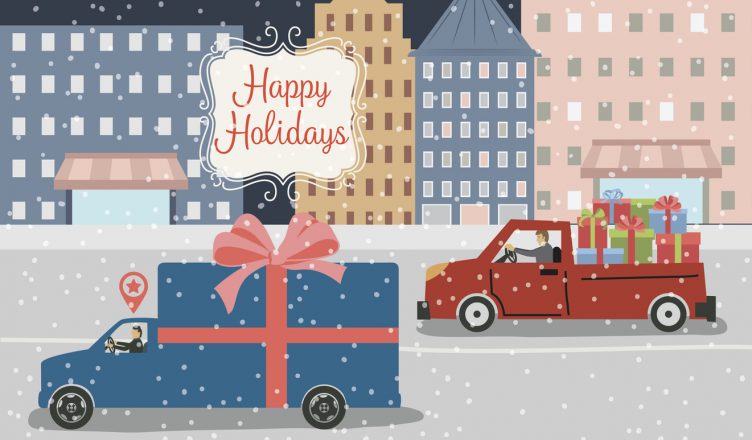The holiday season in the United States is a nostalgic time accompanied by several traditions, such as spending time with family and friends, decorations, and gift-giving. But for those in the e-commerce industry, the holiday season, also known as shopping season, is a pressure-filled, make-or-break opportunity to end the year with maximum revenue.
It is the time of the year when capacity crunches, driver shortages, and regulatory issues that have impacted the logistics industry throughout the year might turn into monumental challenges. To accommodate the spike in delivery volume and to handle extra pressure on infrastructure, DHL, FedEx, and UPS are planning to introduce several new measures. According to a report, UPS plans to hire 100,000 seasonal workers to handle the holiday sales spike.
In an era of high customer acquisition costs and rising customer expectations, e-commerce companies are looking for ways to win both the loyalty and hearts of customers. The majority of them start preparing for the holiday season as early as April or May. So, how is your shipping strategy shaping up to handle the forecasted customer demand?
To help you get ready for the upcoming holiday season, here are the common challenges most field service businesses face, along with the possible solutions:
Cost of Doing Business May Rise During The Holidays
The entire delivery process involves several steps that include many handshakes (and each has a cost). While these costs may vary depending on factors like parcel size, customer and warehouse location, etc. – this expense eats into your profit margins. Driver shortage increases freight costs as drivers take advantage of the greater demand and ask for higher overtime wages. Several other factors such as lack of parking, high parking fines, and traffic congestion also contribute to the high costs of parcel delivery during the shopping season, especially in big cities like Chicago or New York.
Increased Workload May Impact Vehicle Health
For field service businesses, the holiday season brings increased workload. This means the vehicles must run non-stop on the roads to ensure timely deliveries. But you need to ensure that the vehicles are in perfect condition to prevent breakdowns. An unexpected vehicle breakdown will mean a financial loss in the form of repair costs, productivity loss in arranging a back-up vehicle, and the loss of customers due to missed or late deliveries.
The solution is to have a preventive maintenance schedule in place that ensures vehicles go through regular maintenance checks to detect early warning signs of potential problems. Preventative maintenance will also help extend the life of your vehicles since the more you take care of your vehicles, the longer their vital parts will last.

Absence of Real-time Delivery Status Update Damages Customer Experience
For eCommerce businesses, shipping is one of the essential tasks that makes or breaks the customer experience. And, the worst time to mess up customer experience could be during the holiday season.
Delivery updates, including parcel tracking and real-time notifications, are directly related to customer experience, especially during the busy holiday season. This is because customers want to know where their parcels are so they can prepare their gift list and plan last-minute shopping accordingly. According to a report, almost 90% of customers track the delivery status of their parcels and expect the delivery time to fit in with their hectic lifestyles. Sending real-time delivery updates and alerts will also help customers protect their parcels from porch pirates this holiday season. Businesses that give customers the ability to track their packages provide superior customer experience and can differentiate themselves from the competition.
Want To See For Yourself How Route4Me Can Boost Your Profits?

Inefficient Routes Can Negatively Impact Driver Productivity
For your drivers to reach customer locations on time, they must have the most accurate driving directions from one place to another. But you cannot guarantee the shortest or fastest routes using pen and paper. It is essential to use tools, such as Google Maps and route optimization software. Google Maps can give driving directions to drivers and guide them from one point to another, provide real-time traffic information, estimated time of arrival, and turn-by-turn directions. However, Google Maps is more appropriate for personal use.
During the upcoming holiday season, if you need to plan multiple routes for multiple drivers, a route planner is an ideal tool for route planning and optimization. A delivery route planner will help you plan the fastest, safest, and most cost-efficient routes with turn-by-turn directions while considering all factors such as traffic congestion, weather, and under-construction areas that may negatively affect your drivers’ productivity.
Also, an advanced routing optimization software with a built-in dynamic stop insertion feature can help you accommodate last-minute requests by adding or deleting customer addresses and creating a new, efficient route for your drivers.
Dissatisfied Drivers May Result in Unhappy Customers
Most field service businesses face an increased driver dissatisfaction and turnaround, especially during the holiday season. These are alarming issues as it is a difficult task to hire and train professional drivers. Drivers often leave because of long hours on the road, not spending enough time with family, poor communication with management, vehicle maintenance issues, and low wages. To ensure your drivers spend less time on the road and more time at home with family and friends, you must provide them with optimized routes since poorly planned routes mean they will be on the road longer. Also, rewarding them for their hard work will go a long way to motivate them to provide exceptional customer service during the holiday season.
Ignoring Important Factors During Route Planning Impacts Efficiency
Managing delivery distribution during the holiday season is one of the most challenging tasks for field service businesses. Managers often struggle to divide service areas, assign drivers to areas, and to ensure that routes are optimized and drivers are productive. It is crucial to ensure all of these are addressed to have a successful and error-free holiday season. This is where a route planner with multifactor route optimization capabilities can help you improve efficiency and achieve delivery distribution goals. Instead of having all your drivers cover the same service area, you can consider breaking the area up into smaller territories and assign a driver to each territory. This will make drivers more efficient. The software will also show you the location of your drivers in real-time so that you can ensure that everyone is on their assigned routes.
Inefficient Planning Can Reduce Profits
You have mastered expense control, vehicle selection, but the holiday season needs an efficient plan to ensure profitability. Ensuring safe and timely deliveries during the holiday season is expensive. Increased traffic leads to more fuel consumption and hence, more cost. Traffic congestion and enormous delivery volume make drivers stay on the road for long hours. As a result, drivers demand overtime wages, which is again an added cost. With the right strategy, you can reduce these expenses and improve your profits.
By implementing a delivery planner, you can locate all your drivers and vehicles in real-time, allowing you to assign delivery to the driver nearest to the customer location. The software will also help you plan optimized routes and reduce overall driving time, thus improving productivity and reducing fuel expenses.
Vehicle Theft Can Severely Impact Deliveries
In addition to parcel theft, vehicle theft is another significant threat to a field service business. It takes a considerable amount of time to recover lost vehicles, and there are chances of damage to the vehicle.
Knowing the real-time location of your vehicles is the first piece of information, you will need to prevent theft. You will need a delivery route planner with a geofencing feature to track your vehicles’ locations in real-time around a particular area. Geofencing is the ability to build a virtual boundary on a map and to be notified when a vehicle being tracked moves into or out of the defined limit. If a vehicle leaves the ‘geofenced’ area, the onboard system will trigger an alert to inform you that a vehicle may be stolen and is being driven to a non-designated area.
If route diversion occurs due to unforeseen problems, the geofencing feature will help you make timely decisions.
Fatigue Congestion Can Jeopardize Driver Safety
With more vehicles on the road, the risk of a potential crash also increases. It becomes more dangerous when fatigued truck drivers are barreling down the road at high speeds to cover long distances or if they are overtaking other vehicles to meet their delivery schedules. Adverse weather conditions make the situation even more dangerous.
Though not all accidents are preventable, you can take measures to minimize the risk and improve driver safety. Having a route planner software with a GPS tracking feature in place monitors drivers for bad driving habits and ensures that your drivers follow the best route to reach customer locations so that they spend less time driving, thereby reducing the chances of a fatigue-induced collision.
Conclusion
The holiday season is around the corner, and lurking with it is the anxiety of routing and scheduling parcel delivery. Making sure customers get the right item at the right time is about to become the holiday headache of field service businesses across the country.
You can stay on top of the game by finding the best ways to schedule deliveries and keep vehicles and drivers safe. What’s more, you can increase profits and retain customers during the holiday season by making timely delivery your unique selling proposition (USP). Your customers will take note of your proactiveness. These customers will be more likely to continue with your brand since they know that as long as they do business with you, they are in good hands.
Want To See For Yourself How Route4Me Can Boost Your Profits?

